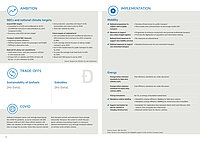Vietnam
Net-zero target: 2050 / Motorisation rate (2020): 680 vehicles per 1,000 inhabitants / Change in transport sector emissions (1990-2019): 755.2 % / Projected total CO2 emissions per capita in the transport sector in 2030: 0.61 t
Vietnam is long and narrow, extending over 1,650 km north to south while varying in width between 50 km and 500 km. Most of the country's population resides along the coasts; Vietnam has a 3.260 km coastline on the South China Sea and Gulf of Tonkin, as well as over 3.000 islands and extensive internal waterways. Accordingly, an exceptionally high share of freight is transported by water. Motorcycles play a major role in passenger transport, with the motorisation rate for two-wheelers being more than double that of cars.
Vietnam aims to reduce GHG emissions from transport by 12% unconditionally and 22% conditionally by 2030 compared to a BAU scenario. Vietnam was one of the few countries to update and significantly increase its NDC ambition in 2022. The country has pledged to reach net zero emissions by 2050. Vietnam is supporting its budding electric vehicle industry and aims to reach a 50% "electric and green energy vehicle" share in passenger cars by 2030. Measures to support a shift towards public transport and rail/water-based freight are currently scarce.
Key figures on transport and climate
Published in Towards Decarbonising Transport Vietnam 2024.








